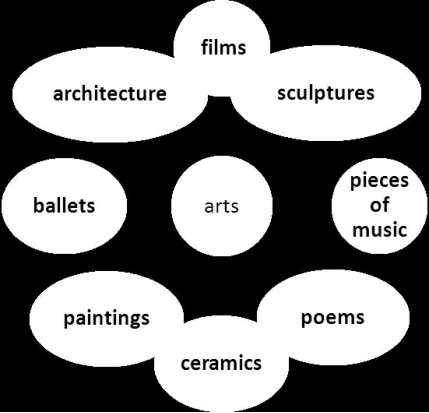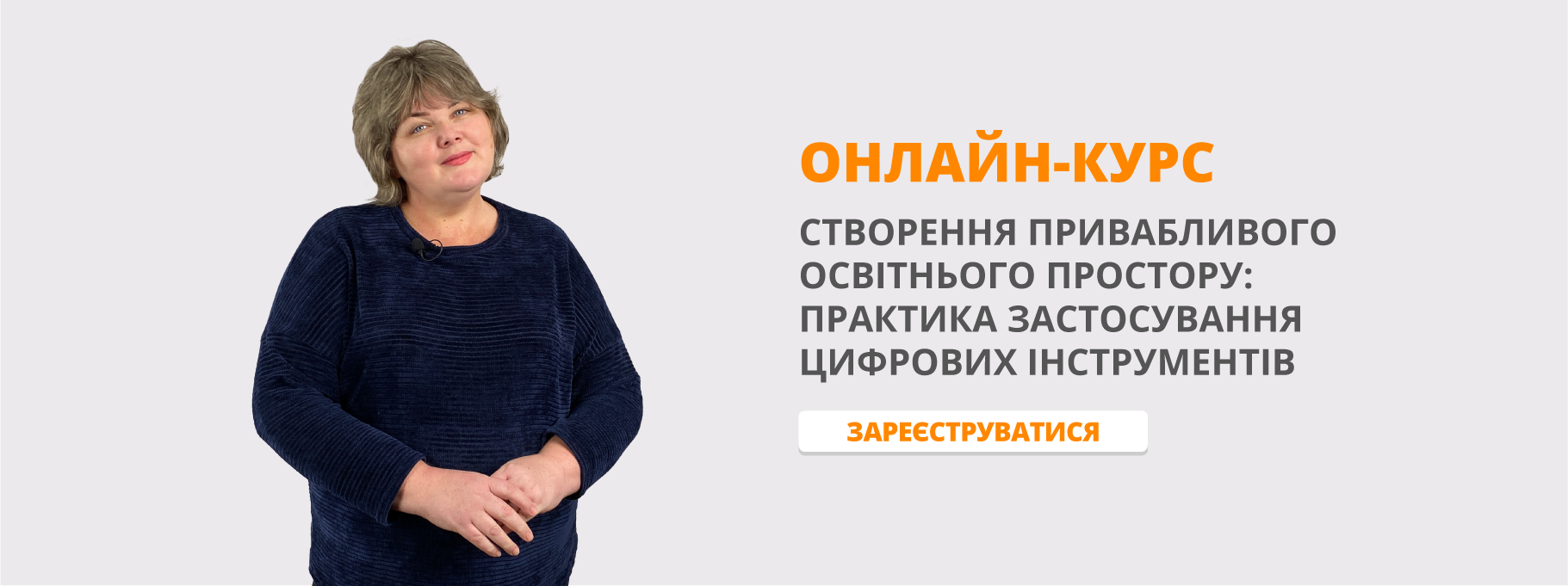Розробка уроку "Види мистецтва"
Theme: Types of Art
Objectives:
- To develop lexical skills; ·
- To form reading skills for specific information, scanning; ·
- To enlarge students’ intellect; ·
- To get acquainted with world possession of art; ·
- To cultivate aesthetic tastes.
Equipment: copies with tasks on the desks, blanks, computer, presentation, sayings and expressions on the blackboard.
Plan
1. Introduction.
2. Warm-up.
2.1Presentation of the topic.
3. Vocabulary Work.
4. Exercising.
5. Relaxation.
6. Pre-reading exercises.
7. Reading.
8. After-reading exercises.
9. Summary.Exam
STAGE CONTENT
1. Introduction T. Glad to see you, dear students. Take your seats.
Look at your desks. Today you do not need any books
or copy-books. Everything has been already done for you. You need only pens.
2. Warm-up Method.
Conversation Look at the blackboard – there are some expressions about art that were said by famous people. They are divided into parts. Your task is to pool parts of sayings. Try to explain them: · Art is long life is short. · Art makes the world go round · Each great work of art has a fascinating story to tell about. · Art is not truth, at least the truth that is given us to understand. · Art has no enemy except ignorance.
2.1. Introduction of the topic
and motto Method.
Discussion T. Today we start speaking on the topic ART. You know that art appeared long long ago and it follows people all their life and everywhere. What do you think, is it important to discuss this topic? S. It is important to speak about art to be art-literate and to refresh our knowledge in this area.
S. I think it is urgent topic because we learn how to analyse different phenomena in art.
T. I agree with you completely. We speak about it because it has different modern phenomena and expressions. And to be well-educated you should have an idea about art generally and its elements particularly. The motto of tоday’s lesson is: “Beauty of the world belongs to all people”.
3. Vocabulary
Work Method
1. Brainstorm T. From the previous form you know what art means, don’t you? (Art is the study or creation of beautiful things.)
T. Let’s refresh your memory and try to name the elements of art: Students one by one put the elements on the blackboard around the word “art”. They prove their ideas Method 
2. Nontranslative method
of lexicalization The main aim of art is “to entertain”. Do you know what does it mean? Can you give the definition?
T. So, let’s look at the examples and try to choose the correct Example definition to each derivative of this word. Look at the blackboard.
entertain, v
a) to invite people to your home for a party
The play failed to entertain the audience.
b) to do something that amuses or
We're entertaining our interests people
neighbours this evening.
c) to take people to a restaurant for a meal
entertainer,n
a) someone who does tricks
I like street entertainers.
b) someone who sings
He is a very popular person who entertains professionally,
television entertainer.
entertainment,n
a) such things as films, television,
This law is applied to performances, etc. that amuse or
theatres, cinemas and interest people other places of entertainment.
b) a performance or show
c) an act of entertaining
It's not a serious film, but it's good entertainment.
Students one by one guess the meaning of the words and
give definitions.
Method 3. Multiple
Choice T.And now let’s use these words on practice.
Read the passages (A-D) and guess what entertainment they
describe.
0 ballet 0 mime 0 musical 0 music hall
A It is a form of entertainment for an audience, which may
include drama, dancing, music, mime, puppetry and so on.
BIt is the art of combining sounds into a unified whole, typically
in accordance with fixed patterns and for an aesthetic purpose.
C It is a modern form of art and entertainment which borrows
from the other arts, such as music, drama and literature, but is
dependent for its origin on technological development.
D. In ancient Greece it was a realistic comedy with speech and
exaggerated gestures. But in common usage it is applied to acting
in which gestures, movements and facial expressions replace
dialogue. It has developed as a form of theatre, particularly in
France.Example
audience, cast, director, plot,
scene, script, sequel, soundtrack,
special effects, star, subtitles
KEYS:
A ballet
B musical
C music hall
D mime
Method 4. Interactive
play. T. Every entertaining item has got its elements. They are very important. No film or other entertainment cannot succed without
them. Let’s guess what they are. Look at the screen. I will read
the definitions and you are to answer what I’m talking about. I
can give you a tip. It is a table with necessary terms. It is in the
right corner of slides.
1cast all the people who act in a film
2 the most important actor or actress in a film
3 person who makes a film
4 music of a film
5story of a film
6 a part of a film happening in one place
7 people who watch a film in a cinema
8 a film which continues the story of an earlier film
9 images, often created by a computer
10 words of the film
11 transcription (usually translation) of the dialogue of a film that appears at the bottom of the screen.The first definition is an example. Then – one by one.
Method 5. Multiple
choice (in groups of
opponents) T. All these elements can be either positive or negative. The nextour exercise is to group up words into two columns according to
the impression. Let’s divide into two groups. The first group works with the positive side and the opponents work with negative ones. Then you exchange your ideas. Besides, you are to make up sentences with these words. Everyone should make up one sentence and write it down.
heartwarming, well-acted, lots of twists and turns, too long,a bit boring, very surprising, gripping, utterly believable,original, predictable
|
Positive Negative |
4. Relaxation T.And now I invite in the world of beauty. Put everything asideand try to relax.Students watch video.
4.Pre-reading exercises
Method 1. Discussion T.Did you enjoy the video? It’s a magic world of “natural art”.Todaywe stop at one of art’s elements – “paintings”. (Students return to the scheme on the blackboard) Remember, if we’re speaking about any of these elements, we can synonymically call them “art”. Eg. Painting=art. And a painter is an artist. These words are synonyms.
Method 2. Translation And now, if we have started to speak about words and synonyms,let’s remind your necessary vocabulary. Look at the screen and
remind the types of art.Students watch presentation and one by one name the types.
Method 3.Role-play T. And now I want to see your tastes and preferences. Complete the sentences. And make up dialogues. Write them down.
1 My preference lies with the genre of portrait because ...
2 I personally like genre paintings. They are ...
3 I prefer landscape to other genres. Yousee ...
4 I care much for still lives ...
5 I prefer battle pieces ...
6 As for me, … appeals to me much.
5 in.Reading (for specific formation,scanning)
6.After-reading T.Now, you are to read the text and do the tasks. First of all, you should divide into groups. Each group will do different tasks.
I – makes up an extended plan.
II – works on the description of the person.
III – works on the description of the details and background.
IV – translates the sentences into English.
PORTRAIT OF DUCHESS DE BEAUFORT
Gainsborough's Portrait of Duchess de Beaufort is an outstanding work
of art. The artist depicts a graceful and attractive young woman. She has a pleasant oval face, straight eyebrows and black eyes, a straight nose and well-shaped delicate hands.You can see that she is an aristocrat.Her rather pale complexion is contrasted by the dark colour of the background (the dark background was traditional in Gainsborough's time).The artist enlivens the face by a little colour on her cheeks.Her grayish hair is combed very high and fastened with a comb and a blue ribbon, as was the fashion in those days. The dress is very low cut, also according to the fashion of the day.The portrait is painted in cold colours (black, blue, grey and white). At first sight you may think that it is a traditional ceremonial portrait, but if you look attentively, you will see thather parted lips, fleeting glance and graceful gesture of her hand help to create a true impression of the sitter's vitality and optimism. The woman in the picture is alive, and we have a feeling that she is looking at us.
T. Now, we’ll check up the task in the following way. The first group represents their point of the plan and each other group adds the necessary information to them. The fourth group represents the task the first.
7.Summary
Method 1. Conversation T. In such a way, we achieved a plan for describing any piece of painting, and we can pass our impression with the help of all studied words and expressions. Look at your copy-books. There are pictures to describe, and exercise to check up your skills.
Method 2. Answering questions T. To understand how much information you remembered I ask you questions:
1 Does art appeal to the heart and mind of man, to his feelings and ideals? Does art serve life?
2 What feelings does art arouse?
to arouse [a’raoz] — збуджувати, викликати
3 What must young people do to understand and enjoy the arts? (To read books about the arts; to take an active part in amateur art activities; tostudy folk music; to listen to music; to learn songs,dances,handicrafts; take up — займатися to to visit art exhibitions,theaters, concerts, museums.)
4 Truthful art is always connected with life. What role does art play in your life? What kind of art appeals to you?
5 Are you a frequent theatregoer? What is your favourite theater (actor, actress)? Why? Do you prefer a comedy,a tragedy, a musical, or a drama?
6 Why do many people prefer cinema to theatre? And what about you? Give your reasons.
7 What role does music play in your life?
8 What kind of music do you like to listen to?
9 Who is your favourite composer(singer,musician, pop group, musical instrument)?
10 Do you take up3music lessons? Where do you study music?
11Do you often go to music concerts?
12 Are you interested in painting?
13 How often do you visit picture galleries or fine arts museums?
14Who is your favourite painter? What is your favourite painting?
T. Do you have any questions to me? Well, your marks. You worked very hard today and I am very satisfied with you.The lesson is over, see you next time.


про публікацію авторської розробки
Додати розробку
